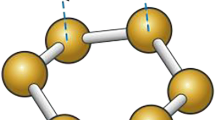Abstract
Structural models are described for three groups of structural defects in TiS2 nanotubes: those which influence the stoichiometry of nanotubes, the local atomic configuration of their walls, and their local morphology (convex or concave walls). Tight-binding band-structure calculations are used to evaluate the energy and electronic properties of “ideal” and imperfect TiS2 nanotubes. The results suggest that the energetically favored defects are those which increase the inner volume of the tubes. In contrast to ideal TiS2 nanotubes, which are all semiconductors, the tubes containing any of the structural defects considered here have metal-like conductivity.
Similar content being viewed by others
REFERENCES
Iijima, S., Helical Microtubules of Graphitic Carbon, Nature (London), 1991, vol. 354, pp. 56–58.
Tanaka, K., Yamabe, T., and Fuku, K., The Science and Technology of Carbon Nanotubes, Oxford: Elsevier, 1999.
Harris, P.J.F., Carbon Nanotubes and Related Structures: New Materials for the Twenty-First Century, Cambridge: Cambridge Univ. Press, 1999.
Ivanovskii, A.L., Kvantovaya khimiya v materialovedenii. Nanotubulyarnye formy veshchestva (Quantum Chemistry in Materials Science: Nanotubular Materials), Yekaterinburg: Ural. Otd. Ross. Akad. Nauk, 1999.
Iijima, S., Carbon Nanotubes: Past, Present, and Future, Physica B (Amsterdam), 2002, vol. 323, no.1, pp. 1–5.
Endo, M., Hayashi, T., Kim, Y., et al., Applications of Carbon Nanotubes in the Twenty-First Century, Philos. Trans. R. Soc. London A, 2004, vol. 362, pp. 2223–2238.
Tenne, R. and Zettl, A.K., Nanotubes from Inorganic Materials, Top. Appl. Phys., 2001, vol. 80, pp. 81–112.
Tenne, R., Inorganic Nanotubes and Fullerene-like Materials, Chem.-Eur. J., 2002, vol. 8, no.23, pp. 5297–5304.
Ivanovskii, A.L., Noncarbon Nanotubes: Synthesis and Modeling, Usp. Khim., 2002, vol. 71, no.3, pp. 203–224.
Zakharova, G.S., Enyashin, A.N., Ivanovskaya, V.V., et al., Titanium and vanadium Oxide Nanotubes: Synthesis and Modeling, Inzh. Fiz., 2003, no. 5, pp. 19–41.
Tenne, R. and Rao, C.N.R., Inorganic Nanotubes, Philos. Trans. R. Soc. London A, 2004, vol. 362, pp. 2099–2125.
Chen, J., Li, S.-L., Tao, Z.-L., et al., Titanium Disulfide Nanotubes as Hydrogen-Storage Materials, J. Am. Chem., Soc., 2003, vol. 125, pp. 5284–5285.
Chen, J., Tao, Z.-L., and Li, S.-L., Lithium Intercalation in Open-Ended TiS2 Nanotubes, Angew. Chem., Int. Ed., 2003, vol. 42, pp. 2147–2151.
Samsonov, G.V. and Vinitskii, I.M., Tugoplavkie soedineniya (Refractory Compounds), Moscow: Metallurgiya, 1976.
Kim, Y.S., Mizuno, M., Tanaka, I., and Adachi, H., Electronic Structure and Chemical Bonding of TiX2 (X = S, Se, and Te), Jpn. J. Appl. Phys., 1998, vol. 37, no.9A, pp. 4878–4883.
Sharma, S., Nautiyal, T., Singh, G.S., et al., Electronic Structure of 1T-TiS2, Phys. Rev., 1999, vol. 59, no.23, pp. 14833–14836.
Enyashin, A.N., Ivanovskaya, V.V., Makurin, Yu.N., and Ivanovskii, A.L., Structure and Electronic Spectrum of Fullerene-like Nanoclusters Based on Mo, Nb, Zr, and Sn Disulfides, Neorg. Mater., 2004, vol. 40, no.4, pp. 466–470 [Inorg. Mater. (Engl. Transl.), vol. 40, no. 4, pp. 395–399].
Enyashin, A.N. and Ivanovskii, A.L., Electronic Structure of Fullerene-like Ti, Zr, Nb, and Mo Disulfide Nanoparticles Evaluated by Nonempirical Calculations, Zh. Neorg. Khim., 2004, vol. 49, no.10, pp. 1654–1658.
Hoffmann, R., Solids and Surfaces: A Chemist's View of Bonding in Extended Structures, New York: VCH, 1988.
Fang, C.M., de Groot, R.A., and Haas, C., Bulk and Surface Electronic Structure of 1T-TiS2 and 1T-TiSe2, Phys. Rev., 1997, vol. 56, no.8, pp. 4455–4463.
Ivanovskaya, V.V. and Seifert, G., Tubular Structures of Titanium Disulfide TiS2, Solid State Commun., 2004, vol. 130, pp. 175–180.
Author information
Authors and Affiliations
Additional information
__________
Translated from Neorganicheskie Materialy, Vol. 41, No. 10, 2005, pp. 1266–1271.
Original Russian Text Copyright © 2005 by Enyashin, Ivanovskii.
Rights and permissions
About this article
Cite this article
Enyashin, A.N., Ivanovskii, A.L. Structural Defects and Electronic Properties of TiS2 Nanotubes. Inorg Mater 41, 1118–1123 (2005). https://doi.org/10.1007/s10789-005-0270-2
Received:
Issue Date:
DOI: https://doi.org/10.1007/s10789-005-0270-2




